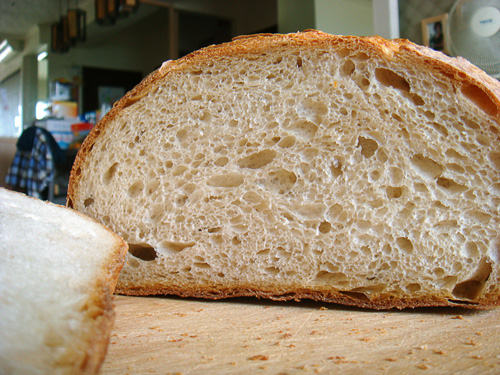
Leaven
- 20g starter @ 100% hydration
- 100g water
- 15g light rye flour*
- 85g all purpose flour
Ferment @ 29C (84F) for 9 hrs.
Sponge
- All of the leaven
- 250g water
- 250g bread flour (12.4% protein)
Allow to sponge @ 28C (82F) for 3 hours.
Main Dough
- All of the sponge
- 65g water
- 250g bread flour (12.4% protein)
Autolyse for 20 mins. Now add:
Knead until gluten moderately to well developed. You need to have the gluten fairly well developed because the bulk ferment is very short. One hour bulk with folds at 20 and 40 mins respectively. Pre-shape. Rest 5. Shape. Place in cloth-lined banneton. Three-quarter proof.(About 1.5 hours). Retard in fridge for 7 - 9 hours. Remove from fridge and allow to final proof (about 1 hour).
Pre-heat oven to 230C (450F). Slash. Load onto baking stone. Immediately reduce heat to 205C (400F), convection off. Bake for 20 mins with steam. Remove steaming appartatus when the top of the bread starts to show signs of colour. Reduce heat to 190C (375F), convection on. Bake a further 25- 30 mins. (You might have to experiment with baking temps/times. I baked this at a lower temp than I usually do for my regular sourdoughs. You don't want to have a deeply caramelized crust like for that of a miche, but rather a reddish-brown crust with nice blistering).
Notes
- hydration is 69%
- for the leaven build I use a very light rye with all the bran removed (for all practical purposes, this is an all-white loaf)
- this loaf improves with flavour on the second day and gets sourer

Taste
It has a distinct but, what I would categorize as, mild sour flavour. This was my third attempt at this recipe and was the least sour of the three. This could be, in part, due to the fact that the weather was slightly cooler and the temperatures were slightly lower than the temperatures when I first formulated this recipe. It could also be due to the fact that I changed the composition of flours. Despite the open looking nature of the crumb shot, it was actually quite firm to the bite. This is undoubtedly the result of the high protein flour. The crust was chewy, too.
Previous attempts
On my first attempt I used 11.4% protein flour for both the sponge and the main dough. I also gave it a 50 min autolyse and added 3g of diastatic malt. The main dough was very sour tasting and got sticky quickly. I attribute this to too much enzymatic activity and the enzymes breaking down the gluten. The resultant loaf had a rather low profile and a moderate to strong sour flavour.
On my second attempt I considered using the same flour but lowering the hydration to counter some of the stickiness. Instead, I kept the hydration the same and used a higher protein flour for the main dough. The result was similar to the first attempt although the main dough wasn't as sticky. The profile was still rather low, though.
For this try, I ditched the diastatic malt, reduced the autolyse to 20 mins and used a 12.4% protein level flour for both the sponge and the main dough. This resulted in the best profile but the mildest flavour of the three.
I want to work on this one a little more. For my next attempt I want to keep everything the same but let it proof for only an hour in the bannetton, then give it double the time (about 16 hours) in the fridge. I am hoping this will get me where I want to be: a moderately sour, chewy loaf with a reddish-brown, blistered crust.

Finally, a different angled view of the whole boule (and a gratuitous crumb shot) for Varda, lest she again accuse me of minimalism (or was it brevity)? :)
Syd